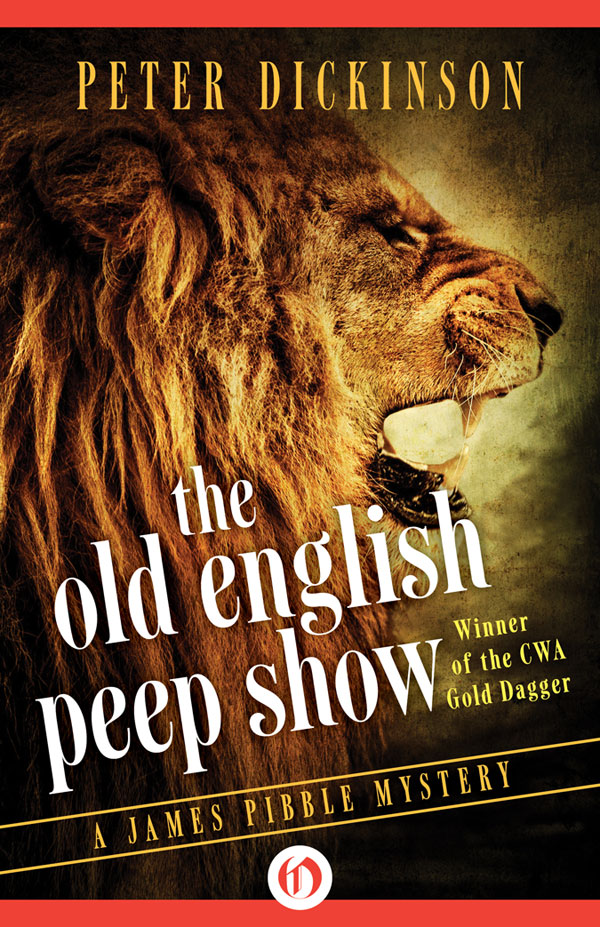The Old English Peep Show
Read The Old English Peep Show Online
Authors: Peter Dickinson



FRESH EBOOK DEALS, DELIVERED DAILY
BE THE FIRST TO KNOW ABOUT
FREE AND DISCOUNTED EBOOKS
NEW DEALS HATCH EVERY DAY
The Old English Peep Show
A James Pibble Mystery
Peter Dickinson

PART I
OLD ENGLAND
Surely among a rich man's flowering lawns,
Amid the rustle of his planted hills,
Life overflows without ambitious pains;
And rains down life until the basin spills,
And mounts more dizzy high the more it rains
As though to choose whatever shape it wills
And never stoop to a mechanical
Or servile shape, at others' beck and call.
âW. B. Yeats, “Ancestral Houses”
10:45 A.M.
P
ibble thought, I am the chosen vulture spiraling down onto a dying lion. A golf course rolled backward past the train windows, where three bright-anoraked couples marched in different directions across the dewy October turf, with the uninterpretable purposefulness of foraging ants. Then acres of birch and withering bracken, interrupted by ponds whose black-tinged water betrayed the sourness of the soil beneathâall so close to London, as though the Almighty had foreseen that His English would need expanses of agriculturally useless land within commuting distance of the money mart. And now, pat, terraces of tidy postwar development with long, thin gardens reaching down to the reedy canal.
In fact the canalâuseless, beautiful, the romantic relic of obsolete needs, now stagnant and full of mosquito larvaeâwas a better image than the lion. Pibble turned a page in the folder of press cuttings on his knee but did not start to read; the greenhouse sensation of the mild sun beating through the carriage window made him mentally lazy, happy to wallow in the absurd melodrama of being the chosen vulture. He rejected the intrusive canal from his imagery, partly because he had recently been bullied by Mrs. Pibble into reading the Elsa books, partly because the stagnant waterway (though otherwise admirably suited to tone in with his own dim, suburban upbringing) provided no role for a visiting detective, but largely because of the comings and goings in Scotland Yard during the past twenty-four hours. That really had been like carrion birds squabbling over a carcass: Tom Scott-Ellis and Harry Brazzil had surprised even their enemies by their eagerness to go down to Herryngs and set Scotland Yard's seal of approval on the run-of-the-mill suicide of an old retainer, until the Ass. Com. had lost patience and sent old Pibble to spite them all. It showed you what a hold the idea and name of Clavering still had on the vulgar imagination.
And the not-so-vulgar, to be honest. Why, otherwise, go in for the melodrama, the picture of the princely quadruped expiring on the veldt while the broad wings loitered down toward it? Supposing Mrs. Pibble ever succeeded in her campaign to make him retire and write his memoirs, would he actually keep the Claverings out because the crime had been uninteresting? Scott-Ellis or Brazzil would milk a visit to Herryngs for a whole chapter, even if their task had been only to find a lost back stud. And
that
wasn't unlikely, either; witness Pibble's present mission. Sir Ralph seemed perfectly capable of sending for a busy crime-buster to come and grovel under his chest of drawers, and getting him, too.
So the lion wasn't quite dead, its limbs were not yet being reconnoitered by ants. But in any other sense the Claverings were finished, irrelevant, a figment of the corporate British Imagination (much like Beefeaters or Stratford-upon-Avon); they were heroes from the age of Sophocles who had survived with endearing absurdity into the age of Menander.
The absurdity was inescapable, seeming to permeate everything they had a hand in these days, witness the press cutting that now lay uppermost in the folder, dated 1958:
INCIDENT AT EPSTEIN UNVEILING
“Statue an Insult”â
Sir R. Clavering
The unveiling of the memorial to Sir George Murrow, R.A., at Framplingfield, Sussex, yesterday, did not go off as smoothly as hoped. The soapstone statue had been commissioned by Sir Cyril Blight, the Lord of the Manor of Framplingfield (Sir Cyril is better known for his extensive interests in property development), in memory of Framplingfield's most aesthetically distinguished son. General Sir Ralph Clavering, hero of the St. Quentin Raid, came out of retirement to perform the unveiling ceremony. Murrow had been an official War Artist attached to the Raid.
Opposite Trenches
In a brief speech Sir Ralph reminded his audience of Murrow's achievements, and of his place in the affections of the British public as a painter of animal subjects. He spoke movingly of the fact that Sir Jacob Epstein, who had spent most of his life in what Sir Ralph referred to as the “opposite trenches of the art world,” had consented to bury the hatchet and produce the monument which Sir Cyril Blight's generosity had made possible.
Sir Ralph then unveiled the monument, and the band of the 7th Marine Commandos struck up “Abide with Me.”
Photograph Confusion?
On seeing the statue, however (it is two-thirds life-size and portrays the artist in striking pose with brush and palette), Sir Ralph vaulted the rails of the unveiling dais, seized the baton from the sergeant-conductor, stopped the band, and ordered the Commandos to reveil the monument. Sir Ralph is Colonel of the Regiment.
While the reveiling was proceeding, Sir Ralph held an impromptu Press Conference and explained the reason for his action.
The statue, he alleged, was nothing like the late Sir George Murrow. It was an insult, no doubt unintentional, to a great artist and a great comrade-in-arms.
Sir Ralph suggested that perhaps Sir Jacob had confused the photographs from which he was working with those concerning some other commission. You could not expect artists to be as efficient as other folk. He knew of several stained-glass windows where a similar error had occurred.
Re-unveiling
Sir Ralph added as he left the Conference that he was most distressed that Sir Cyril Blight's attempt at generosity had miscarried in this way. One must, he suggested, learn to take the rough with the smooth.
As soon as Sir Ralph had departed for Herryngs, the statue was re-unveiled on Sir Cyril Blight's instructions. Neither Sir Cyril nor Sir Jacob Epstein was available to comment last night.
Our Art Correspondent Writes:
Sir Ralph Clavering's strictures on the Murrow memorial caused considerable surprise in aesthetic circles. The statue was shown last autumn as part of a one-man show at the Marlborough Galleries, and was thought by almost all Murrow's acquaintances to be an excellent likeness, carried off with verve and panache, the half-heroic stance made attractive by a strong satiric undertone such as one associates with a Sargent portrait. I do not know whether Sir Ralph Clavering visited the exhibition, but I certainly saw Sir Richard at the Private View.
Too many flaming knights, thought Pibble. No, Sir Ralph's a Bart. There was a photograph of Sir Ralph pulling the cord, and another of the disputed statue; Sir Ralph had chosen to sport tropical military uniformâwhitesâbedizened with every medal and decoration to which he was entitled, and had topped the confection off with a feathered cocked hat. The next cutting was from the following day's “Peterborough” column in the
Daily Telegraph,
a paragraph discussing whether Sir Ralph was allowed by military etiquette to dress like that in England, and whether it had ever been done before by a retired General. He was, the writer decided, and it hadn't.
Pibble leafed back through the folder for a photograph he remembered of Sir Richard in uniform, but when he found it it wasn't a fair comparison. The Admiral had been pictured in a very somber attire at his sister-in-law's funeral; the caption said he had flown in from his NATO command that morning. Sir Ralph was in the background of the same picture, just as soberly dressed; they were fairly alike, but not outstandingly so, compared with other twins. Of course Sir Ralph's mustache made a difference. You could see that Sir Richard was, in their nanny's famous phrase, “the quiet one.” Pibble wondered whether there was a single retainer who had known the heroes of St. Quentin in childhood and whose reminiscences of them had not been taped and broadcast in the euphoria of that exhilarating defeat.
Most of the later cuttings were about Herryngs, and its recent blossoming into a Division One Stately Home. There was even an absurd correspondence from the
Times,
the Marquess of Bath and Sir Richard Clavering disputing about whose lions were wilder. There were gossip-column paragraphs about jousts and other tourist-attracting nonsense; the last cutting in the folder was a paragraph from “London Diary” in the
New Statesman,
in which Paul Johnson complained of the immorality of staging a mock hanging to earn a few dollars.
Pibble turned back to the yellow, fuzzy-pictured pages at the beginning of the folder, and was once again surprised at how Sir Richard had seemed the main hero at first. After all, Sir Ralph had undoubtedly been defeated, even if it was at a time when England was so starved of victories that a dashing defeat could set us dancing in the streets. We had made it Narvik and Dieppe and Dunkirk and Copenhagen and Quebec all rolled into one; and Sir Ralph, sent on an impossible enterprise which was shored by self-contradictory planning, had actually blocked two of the St. Quentin submarine pens and completely demolished the third; he'd lost 60 per cent of his force but had held out three days longer than anyone gave him a chance to; and then Richard, handling his miscellaneous flotilla with crazy precision among the puckered shoals, had disobeyed the express orders of a panicking Admiralty and brought the survivors off. Further on, the cuttings contained a reproduction of old Murrow's picture of that lump-in-the-throat moment when Sir Ralph had scrambled with his tiny rear guard into his brother's riddled boat, while a fantastic series of improvised demolitions and booby traps (“Ah, Master Ralph were always a one for practical joking!”âa pensioned undergardener) gave them a bare chance to escape. Murrow had made a mess of the episode, of course, except for a brilliantly sketched mule which he had managed (in defiance of history) to sneak into the scene, but Pibble found that the lump was in his throat all the same.
Then came the book reviews. At first they had been of I-was-there stories, but the myth was already powerful and the reviews were longer than is usually allowed for a drably written account of a senseless muddle. The competition from other war books stiffened, but St. Quentin seemed always to attract the worthwhile historians and the big-name critics. It had the distinction of being the first British exploit of the war to attract a full-scale debunking, but even the hardy young don who had flailed so vigorously into the myth, cataloguing order and counterorder, weighing the ineptitude of the War Office against the dilatoriness of the Admiralty in a prodigious libration of crassness, had excepted the Clavering brothers from his wrath. Pibble remembered reading the actual book, which had belied its notoriety by being a scholarly and well-managed account of the action; the reviewer quoted that phrase of Shaw's about the British soldier being able to stand up to anything except the British War Office.
Pibble picked about in the folder and found himself reading a cutting from
New Society
in which a well-known tellymath analyzed the position of the Claverings in the British social structure on the twenty-fifth anniversary of the Raid. It was an oddly mealymouthed bit of work from someone normally so glib with his condemnations, so ready to cast the first stone, so happy to pick the peeling whitewash off any sepulcher; evidently he did relish explaining why we all, even the unconnable writer, reverenced a pair of old war horses who had done nothing (unless you counted turning their ancestral home into a nine-month fairground) since that ambiguous adventure. He came to the conclusion that it was the nothing-doing which accounted for the nation's love; never had the Claverings attempted to turn their prestige back into action, to pronounce panaceas for the world's ills, to go globe-trotting and become pally with potentates, or even to make speeches demanding bigger and deadlier armies and navies. Occasionally they had written to the papers, as in the matter of the lions: there was another
Times
correspondence in which Sir Ralph defended his action of having a thousand cuckoos trapped in Africa, flying them into England in a friend's plane, and releasing them in Hampshire in the middle of February. He argued (as he had later in court) that a cuckoo brought here by airplane was unlikely to be more or less diseased than one which had migrated unaided.
But if Sir Ralph had done nothing except mar Sir Cyril Blight's venture into generosity, Sir Richard had been even more quiescent. Apart from his sudden concern with the wildness of lions, his only interest during the whole generation since V-J Day seemed to have been, during the great debunking era, to write to the press to defend this or that scapegoat as a brilliant and courageous officer who had met with unforeseeable bad luck. Each letter was cast in almost the same terms as the last, except that he had reserved his most vehement praise for the most notorious buffoons. He had also steadfastly attended their funerals.
The train, after running through several miles of that southern parkland which suggests to the traveler that there are areas of England where Lady Catherine de Burgh still rules inviolate among her neighbors, ceased from its humming motion and began hawing. The brakes groaned as they took on the task of annihilating the momentum of four hundred tons of wood and metal and fellow travelers, in order that a measly Detective Superintendent should alight at Herryngs Halt. As Pibble slid the fat folder into his briefcase, he remembered the cutting in it which told how a Scottish Liberal had asked the Minister of Transport why trainloads of holidaymakers should be uneconomically stopped and started again at this tiny, nowhere-serving station. He had been booed from both sides of the House.
But when Pibble stepped down onto the sleeper-built platform he found that he was by no means the only one. Two reserved-carriage-loads of tourists were streaming out of doors farther up the train, some with cameras already clicking; the mere name of Herryngs in green-and-white B.R. lettering would make a grandly romantic introit to a half hour of film or a rackful of slides. Dragomans shouted and exhorted; a top-hatted station-master bowed and smiled, obsequious to the smell of dollars; two sleek coaches waited beyond the railings. Pibble decided to let the welter of visitors disappear before he looked for his police car, and when the coaches had sighed away he found that the stationmaster had changed his topper for a scruffy cap before collecting his ticket.

